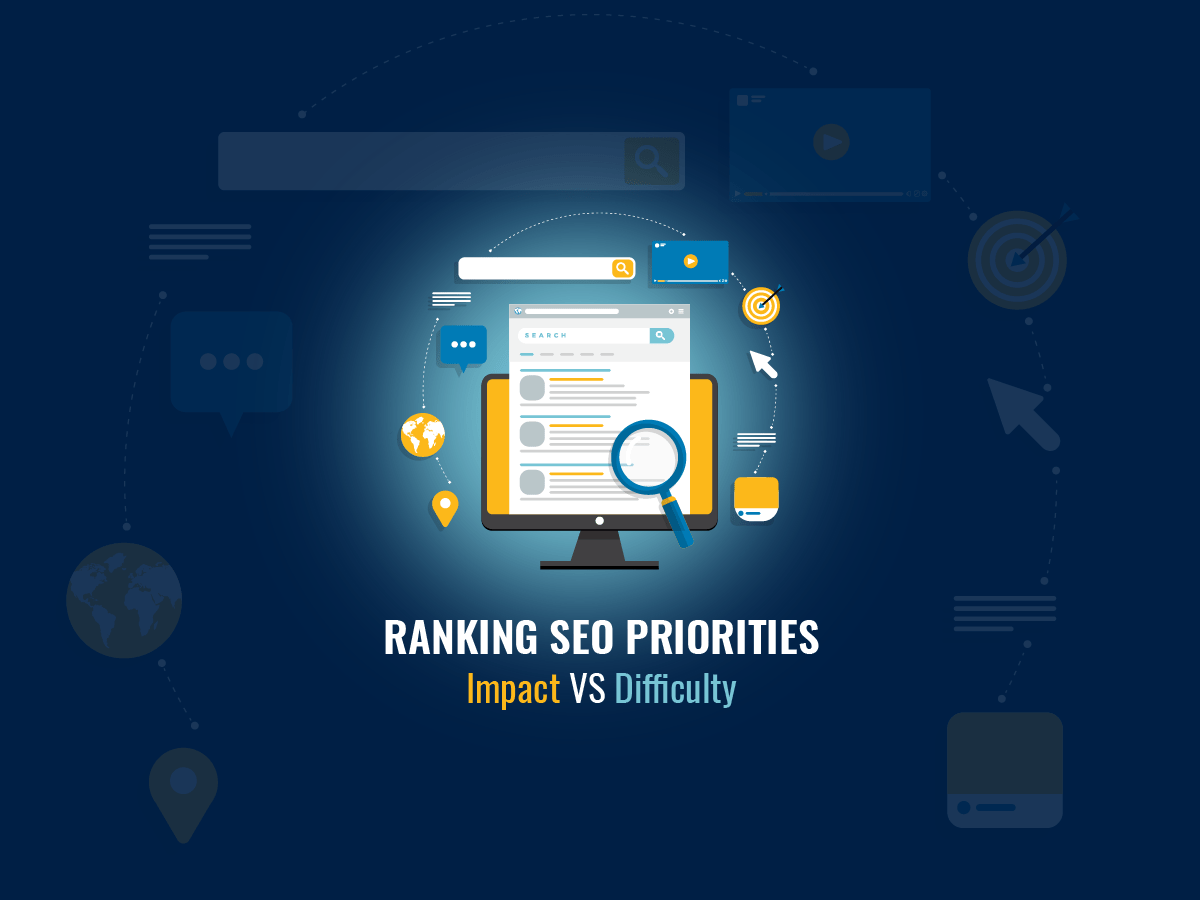A Comprehensive Guide to SEO Strategy
When it comes to Search Engine Optimization (SEO), there’s an abundance of guidance and optimization recommendations, so determining which SEO priorities to implement is no easy task. You can drive yourself crazy monitoring Google’s algorithm and search engine volatility, but getting bogged down in the details can cause you to spend too much time and money on the wrong tasks.
Here’s a quadrant chart that can help you determine which SEO efforts will be easiest to implement and deliver the greatest impact—helping your website earn more quality traffic.
Top 13 SEO Tactics ranked by Impact and Difficulty
The below SEO chart measures SEO impact on the y-axis and difficulty on the x-axis. We should note that all the tactics displayed on this chart are important for SEO; if you want to put your best foot forward, you’ll want to consider each of these strategies. This chart and the descriptions below should help you prioritize which efforts to tackle first and/or spend the most time on.
Here is your official SEO Priority List:
13. Page Speed / Website Load Time Optimization
It makes sense that a slow website can impact your engagement rates, as visitors will react with confusion or impatience when your page doesn’t load as they’d expect. As a result, Google has included page speed as one of their many ranking factors for SEO. In 2021, Google added Core Web Vitals to their Page Experience Algorithm Update, which basically means fast-loading websites will rank higher than slow ones, if all else is equal.
Note: “if all else is equal” is a huge component when it comes to prioritizing page speed optimizations. It’s been over a year since Google adjusted its algorithm to prioritize page speed, and here’s what we’ve learned:
Page speed is just one small part of one of Google’s many ranking signals. Improving your speed can make a positive difference for SEO, but perfecting your load times can be very difficult, and the impact is usually minimal dependent on several factors.
- Page speed is more important for sites that get a lot of traffic. The more traffic potential you have, the higher you should prioritize page speed.
- If your site receives less than a few hundred visitors per month, Google won’t have enough field data to determine the speed of your website.
- Page speed is relative to your competition in the Search Engine Result Pages (SERPs).
- If your site is already faster than your organic competitors, you won’t be able to get additional traffic by making your site even faster.
- Websites that are slower than competitors should put higher priority on page speed.
- Once you meet Google’s “good” user experience benchmarks for Core Web Vitals, you shouldn’t expect to see additional results with additional optimization. For the most part, only the websites that receive the “needs improvement” or “poor” Core Web Vitals ratings will benefit from making speed enhancements.

Reach out for an SEO audit if you’d like to learn more about your website’s speed issues or opportunities.
12. History of Authority
Building credibility and authority over time will impress both your visitors and the search engines. Unfortunately, there’s no shortcut for establishing historical credibility, making this tactic the most difficult to implement on the list. But establishing authority will pay dividends in the long run.
For example, imagine a new website publishing the same article at the same time as Forbes.com. Forbes has been established as a reputable source of information over time; millions of people visit the site daily, millions of other sites link to the Forbes domain, and they’ve established a reputation of being a source for spam-free, quality content. It’s no surprise sites with historical authority receive higher ranks and more organic traffic than less established sites.

SEO Success of Forbes Over the Past 5 Years (Source: SpyFu)
Search engines like Google reward you for the reputation you build over time. Consistency is the key to building SEO momentum that can snowball.
11. User Experience (UX), Navigation, and Site Structure
Improving your website’s UX, along with ensuring optimal accessibility via navigation and organization of your website, can lead to better engagement rates. Those improved engagement rates will in turn lead to greater SEO success.
It’s critical to SEO to provide a great user experience. Google knows, for example, if users have a good experience when they visit your site and spend meaningful time on it, or if they immediately hit the “back” button to find a better search result. Providing the right information in the right format and in the right place for your target audience can be a serious challenge, but UX improvements will improve your SEO—while increasing your conversion rates.
10. Image Alt Text
Alternative text, or alt text, is a snippet of text you can use to describe any image you add to your website. If you have images that are purely decorative it’s okay to omit alt text, but alt text serves two important purposes:
- Visitors relying on screen readers (likely due to having visibility impairments) will read or listen to the alt text to understand what your website image is communicating. Providing this thoughtful level of accessibility can lead to a better overall website experience.
- Search engines can’t understand images the same way humans can, so they use the alt text to understand the image context. Adding relevant alt text will improve your success in image search results, but also give you a better chance to rank for normal web searches. For example, if you perform a search about the different types of frog species, you’re probably going to find results with image-rich content. Google knows that someone searching for different frog species would probably appreciate seeing what each frog looks like. And the same goes for many types of searches – using visuals (with alt-text) to support your copy will set you up for SEO success.
Adding alt text is easy, and we recommend you do it right from the start. It only takes a few seconds during your process of uploading an image, but once you add hundreds, thousands, or millions of images to your website over time, it becomes much more tedious and difficult to go back and add all that SEO-boosting alt text.
Bonus tip: Use relevant file names and optimize file sizes before uploading images to your website. Search engines can also read file names, and the reduced file sizes will help with page speed.
9. Earning Quality Backlinks
Building backlinks is a core fundamental to SEO success. We’ve already covered why backlinks are so important for SEO, but to paraphrase, backlinks serve two purposes:
- Backlinks give you the opportunity to earn referral traffic from other websites.
- Search engines like Google look at those backlinks as votes of credibility to determine the quality of a website.
Your goal should be to earn many relevant backlinks from high-quality sites which themselves receive lots of organic traffic. Earning quality backlinks will make a noticeable impact on your SEO success. Per Backlinko, the average top-ranked search result in Google searches has an average of 3.8 times more backlinks than the rest of the top ten results. However, earning backlinks is a challenging task; simply requesting backlinks from high-authority websites rarely works out, so we’ve written a guide to help you determine the easiest way to build backlinks.
8. Schema Implementation
Schema markup, also known as structured data, is a form of microdata you can add to your webpages to help search engines understand your content. It’s admittedly technical and complex, so we’ll try to keep it simple.
There are different types of schema for different types of web content. Adding schema to help clarify what type of content you publish can make you eligible for rich results in the SERPs. For example, if you publish recipes, there is recipe schema that makes you eligible for “Recipe Rich Results” (see the screenshot below for an example of this type of Rich Result).
Notice how a Google search for “chuck roll recipe” yields recipe results (with images) showing up at the top of the search results. These types of results are called “Rich Results.”

The Recipe Rich Result shown above is just one type of rich result you can earn on Google. The more searches you perform on Google, the more you’ll notice different types of Rich Results or featured snippets showing up at or near the top of SERPs.
Different schema types can help you earn different types of results. Here are some common schema types that might work for your website:
- Article Schema – give your blogs or news stories the best chance to earn rich results
- Product Schema – help search engines better understand your product information
- Video Schema – set your videos up for SEO success
- Organization Schema – help ensure your correct name, location, contact info, social profiles, and logo appear in the SERPs
- FAQ Schema – apply this to your FAQ page(s)
- Event Schema – help your events to be featured as rich results in the SERPs
- Recipe Schema – earn recipe-rich results like the example shown above
- Review or Rating Schema – help your positive reviews show up in the SERPs (hopefully get five gold stars next to your search result)
- Many other schema types – we recommend reviewing Google’s search gallery to see different structured data types and how they can help you earn Rich Results in the SERPs
Depending on your website and the type of content you publish, adding Schema markup may not make a noticeable difference. But it also has the potential to act like an SEO “cheat code,” unlocking a ton of extra exposure at the top of the SERPs.
Schema implementation can also range from easy to complex. Your site may have plugins and content management systems (CMSs) that automatically apply the correct Schema type for your content. Other sites, however, might require skilled developers to input complex code. Regardless, schema markup has high potential for boosting SEO, and we regard it as a tactic every website should consider.
7. Publishing Simple Content
(mostly short format and plain text)
We all know quality content is key to SEO success, but the definition of “quality” here can be hard to distinguish. That’s why we’ve added two separate types of content on our chart of SEO priorities: Rich Content and Simple Content.
We’re defining simple content as content that is mostly short-format text. Simple content could include a couple images, but it doesn’t have videos or infographics and it’s lacking comprehensiveness (it only addresses one small topic but doesn’t provide supporting context or related information). The benefit is that short and sweet content can allow you to answer common questions without too much fluff.
Simple content can align with search intent and it’s fairly easy to produce: just add a new blog or page to your site, write the copy, and hit publish. At the very least we recommend you build a well-organized website (reference #10 above) that leverages some form of content to:
- Describe your business and your products, services, or solutions.
- Answer your target audience’s common pain points and questions.
6. Publishing Rich Content
(comprehensive content with videos, infographics, images, etc.)
Rich content is a couple steps up from the simple content we covered above. Although you can achieve quality and match search intent with short-format text, rich content sets you up for additional engagement and improved SEO success.
According to Backlinko, the wordcount on Google’s top search results have an average of 1,447 words. This is about four-to-five minutes of reading time. Also, Jeff Bullas reports that articles containing relevant images have, on average, 94% more total views than articles without images.
Just imagine if we published this blog without the above visual chart showcasing how SEO priorities compare on impact and difficulty. Visual graphics clearly add value and help us communicate concepts and perspectives.
5. HTTPS Security
Hypertext transfer protocol secure (HTTPS) is a secure and encrypted protocol used to send data between a website and web browser. The insecure version is known as HTTP – any pages using HTTP are likely missing out on SEO potential.
Achieving HTTPS security is relatively simple, as the majority of web hosts offer security certificates to help attain the secured lock icon next to your URL in the browser bar.

If your site is not HTTPS secure, search engines may warn people about visiting your site, or even worse, not rank your site at all. You’ve probably already tackled this; if so, skip to the next step. If not, we strongly recommend you add security; it’s easy and makes a noticeable SEO impact.
4. Mobile Friendly
According to Statista, 63% of organic search engine visits occurred on mobile devices in the fourth quarter of 2021. With more than half of all searches being performed on a mobile device, it’s critical that your website is mobile friendly. Mobile friendliness is a component of Google’s algorithm, so if your content doesn’t display well on a mobile phone, you’re missing out on SEO potential.
Most CMSs ensure your content is responsive—that your web page displays accurately regardless of smaller screen sizes—so basic mobile-friendly design is fairly simple. But beyond basic, to maximize your SEO you should ensure your mobile site meets the following criteria:
- Your content remains well organized.
- Your navigation menu is still easy to use.
- Content is never wider than the screen.
- Text and images are large enough to read.
- Links are far enough part to prevent accidental or incorrect link clicks.
Keep in mind that mobile searches could also be voice searches, so be sure to optimize for longtail keywords or natural language search phrases.
3. Writing or Rewriting Title Tags and Meta Descriptions
Your title tag and meta description are the main title shown when Google displays one of your pages in SERPs. Title tags are not just a ranking factor; optimizing title tags and meta descriptions can improve SEO click-through rates, which further affect your rankings. Be sure to write keyword-optimized, intriguing meta info.
Here’s an example of a search engine optimized title tag and meta description showing up in Google search results:
We should note that search engines like Google sometimes rewrite the title tag and meta description that you specify, usually using other copy from the page they’re ranking. Regardless, your title tag is still a ranking factor and it’s important to put your best foot forward in the event that Google does display the meta info you provide.
Tools like Screaming Frog or marketing agencies can crawl your web pages and give you an export of all your title tags and meta descriptions. Depending on the number of pages on your site, it’s a simple task to ensure you don’t have anything missing and your meta info is search engine optimized. Depending on your CMS or website, it’s almost as easy to add the new title tags and meta descriptions to your site. Doing this is one of the top “bang for your buck” SEO strategies you can leverage.
Bonus tip: Title tags with over 65 characters and meta descriptions with over 155 characters could get truncated and/or might be more likely to be rewritten in the SERPs.
2. Refreshing Your Existing Content for SEO
Did you know that Google will tell you exactly which pages on your site rank for which search queries? This includes what position you rank in and how many clicks and impressions those pages get over any time period within the past 16 months!
All this beneficial data is available in Google Search Console. It’s critical that you look at which pages are showcasing potential on Google Search (or maybe which pages have success but are starting to slip). Then analyze which queries those pages are ranking for, and refresh the content to better align with search intent.
For example, the screenshot below shows that a couple of our other blogs are driving thousands of impressions on Google Search, but not yet ranking well enough to drive a significant click-through rate. Google Search Console will tell us which queries are driving those thousands of impressions, and help us determine which keywords to leverage when refreshing these pieces of content.

Ultimately, Google is trying to rank the webpages that best align with search intent, so spending your time doing other SEO tasks might be a waste of time. Refreshing existing content could include any of the tactics we’ve mentioned above, but for the most part you should prioritize the tactics that carry the most weight: improving the title tag and meta description, ensuring the page is optimized for mobile, or adding rich or simple content to align with search intent.
Search Console is a powerful tool to help you understand striking-distance opportunities and which pages to refresh, but it’s not the only tool in your kit. You know better than anyone your customers common questions and pain points. As those questions evolve over time, you should evolve your site as well.
SEO success is never guaranteed, but strategically refreshing content is one of the most predictable tactics you can implement.
1. Hiring Element
Like we mentioned in the intro, there are tons of SEO tactics. We hope the 12 we outlined above can help you prioritize where to spend your time. And, if you want us to tackle this work for you, contact us today. We’d be happy to combine our SEO savvy with your industry expertise to help your website earn the most qualified organic traffic possible. We’ll make it easy—and impactful.










